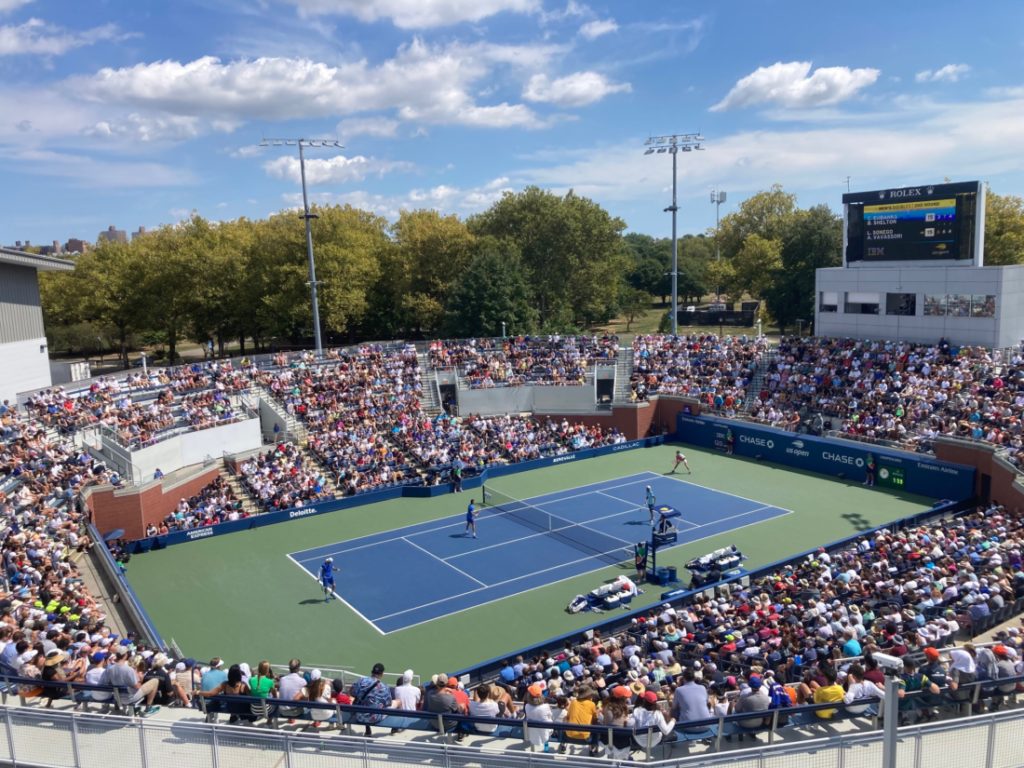By Randy Walker
@TennisPublisher
Labor Day weekend is THE time to be at the U.S. Open. The grounds of the USTA Billie Jean King National Tennis swells over the three-day American holiday weekend as many tennis fans from across the country converge on New York and make attending the U.S. Open the centerpiece of their trip.
While this three-day period is perceived as the “peak” time to attend the U.S. Open, a subtle change in the schedule years ago made this weekend’s ticket slightly less attractive for those fans entirely focused on watching top-flight singles tennis, especially with a grounds pass, which is extremely popular over this weekend. With another slight alteration of the schedule and more value and content could be added to this highly popular tennis ticket.
The Saturday and Sunday sessions of the U.S. Open over Labor Day used to have eight men’s singles matches each day, but now it’s just on Saturday. If organizers delayed the start of doubles competition from a first Wednesday start to either Thursday or Friday, it would not only add more content for the grounds over Labor Day weekend, but may also allow for bigger name singles players to also compete in the doubles, providing more star attraction to the grounds.
Stay with me here…
Years ago, the U.S. Open used to stretch out first round men’s matches over three days, so second round matches would be played on Thursday and Friday of the first week, then third round matches on Saturday and Sunday over Labor Day. This provided for extra “content” on the outer courts. This meant that there would be eight third round men’s matches on the Saturday and Sunday sessions over Labor Day weekend. This meant that you would have two men’s matches on Arthur Ashe Stadium (one for the day session and one for the night) and then perhaps two or three on Louis Armstrong (let’s say three for arguments sake), then you would have three more men’s matches to be played on either Grandstand or another field court, which more than provided for an appetizing selection of men’s matches. The women have, traditionally for years, had their matches played in the two-day intervals, so the middle Saturday would have eight third-round women’s singles matches and Sunday (and Monday) would have only four women’s fourth round matches.
On the first two days of play, you have half of each respective singles draw playing. Therefore, you have 32 men’s singles matches and 32 women’s singles matches on the first Monday and Tuesday of the tournament. That’s a lot of matches! On the first Wednesday and first Thursday, you then have half of the second round men’s and women’s singles for each that. That’s 16 men’s singles matches and 16 women’s singles matches each day – for 32 matches each day. That’s still a healthy amount of tennis for fans. If you start doubles on Wednesday and continue with first-round matches through Thursday, those matches get diluted on an already packed schedule of singles matches.
On the first Friday and Saturday, this is where you get a little thin with the singles matches. You will only have eight men’s singles matches and eight women’s singles matches each day. These are third round matches. This is where you need to start to fill the courts with more content. This is where you could target to START the doubles competition. As you can see from my video here https://www.youtube.com/watch?v=3fGp1JzwEsM and here https://www.youtube.com/watch?v=dxvVLob-_uQ&t=25s the U.S. Open schedule is a bit light on the first Friday and Saturday.
In an exchange on Twitter earlier this year discussing this topic, former Australian Open tournament director Paul McNamee tweeted “We did the sign in at the end of the first round of singles at the Australian Open (where 64 men have already lost), and got the strongest entry of singles players we had ever had… we did it, it works, and I fully endorse it.”
Here’s how I would pace out a tournament match schedule to better maximize content over Labor Day weekend for fans and also, perhaps provide for better match pacing and also perhaps to alleviate early stress in player operations during the first week.
FIRST MONDAY (32 men’s first round singles matches, 32 women’s first round singles matches)
FIRST TUESDAY (32 men’s first round singles matches, 32 women’s first round singles matches)
FIRST WEDNESDAY (16 men’s second round singles matches, 16 women’s second round singles matches)
FIRST THURSDAY (16 men’s second round singles matches, 16 women’s second round singles matches)
FIRST FRIDAY (8 men’s third round singles, 8 women’s third round singles – 32 first round men’s and women’s doubles matches)
LABOR DAY SATURDAY (8 third round men’s singles, 8 third round women’s singles – 32 first round men’s and women’s doubles matches)
LABOR DAY SUNDAY (4 men’s fourth round singles, 4 women’s fourth round singles – 16 second round men’s and women’s doubles matches, 8 first round mixed doubles matches, JUNIORS START (32 junior singles matches)
LABOR DAY MONDAY ( 4 men’s fourth round singles, 4 women’s fourth round singles – 16 second round men’s and women’s doubles matches, 8 first round mixed doubles matches JUNIORS (32 junior singles matches)
SECOND TUESDAY (2 men’s quarterfinal singles, 2 women’s quarterfinals singles – 16 third round men’s and women’s doubles matches, 8 round of 16 mixed doubles matches, 16 junior singles, junior doubles start)
SECOND WEDNESDAY (2 men’s quarterfinals singles, 2 women’s quarterfinals singles – 8 quarterfinal men’s and women’s doubles matches, 4 quarterfinal mixed doubles, 16 junior singles plus junior doubles)
THURSDAY (2 women’s semifinals, 2 men’s doubles semifinals, 2 mixed doubles semifinals, 16 junior singles, junior doubles)
FRIDAY (2 men’s semifinals, 1 mixed doubles final to start the day on Ashe, (2 women’s doubles semifinals), 8 junior quarterfinal singles)
SATURDAY (1 women’s singles final, 1 men’s doubles final – 4 junior semifinals)
SUNDAY (1 men’s final, 1 women’s doubles final – 2 junior finals)

